Second Scientific Lecture-Course:
Warmth Course
GA 321
Lecture III
3 March 1920, Stuttgart
My dear friends,
Today in order to press toward the goal of the first of these lectures, we will consider some of the relations between the being of heat and the so-called state of aggregation. By this state of aggregation I mean what I referred to yesterday as called in the ancient view of the physical world, earth, water, air. You are acquainted with the fact that earth, water, and air, or as they are called today, solid, fluid, and gaseous bodies may be transformed one into another. In this process however, a peculiar phenomenon shows itself so far as heat relations are concerned. I will first describe the phenomenon and then we will demonstrate it in a simple fashion. If we select any solid body and heat it, it will become warmer and warmer and finally come to a point where it will go over from the solid to the fluid condition. By means of a thermometer we can determine that as the body absorbs heat, its temperature rises. At the moment when the body begins to melt, to become fluid, the thermometer ceases rising. It remains stationary until the entire body has become fluid, and only begins to rise again when all of the solid is melted. Thus we can say: during the process of melting, the thermometer shows no increase in temperature. It must not be concluded from this however, that no heat is being absorbed. For if we discontinue heating, the process of melting will stop. (I will speak more of this subsequently.) Heat must be added in order to bring about melting, but the heat does not show itself in the form of an increase in temperature on the thermometer. The instrument begins to show an increase in temperature only when the melting has entirely finished, and the liquid formed from the solid begins to take up the heat. Let us consider this phenomenon carefully. For you see, this phenomenon shows discontinuity to exist in the process of temperature rise. We will collect a number of such facts and these can lead us to a comprehensive view of heat unless we go over to some reasoned-out theory. We have prepared here this solid body, sodium thiosulphate, which solid we will melt. You see here a temperature of about 25° C. Now we will proceed to heat this body and I will request someone to come up and watch the temperature to verify the fact that while the body is melting the temperature does not rise.(Note: The thermometer went to 48° C. which is the melting point of sodium thiosulphate, and remained there until the substance had melted.) Now the thermometer rises rapidly, since the melting is complete, although it remained stationary during the entire process of melting.
Suppose we illustrate this occurrence in a simple way, as follows: The temperature rise we will consider as a line sloping upward in this fashion (Fig. 1). Assume we have raised the temperature to the melting point as it is called. So far as the thermometer shows, the temperature again rises. It can be shown that through this further temperature rise, with its corresponding addition of heat, the liquid in question expands. Now if we heat such a melted body further, the temperature rises again from the point at which melting took place (dotted line.) It rises as long as the body remains fluid. We can then come upon another point at which the liquid begins to boil. Again we have the same phenomenon as before. The thermometer shows no further temperature rise until the entire liquid is vaporized. At the moment when the fluid has vaporized, we would find by holding the thermometer in the vapor that it again shows a temperature rise (dot-dash line.) You can see here that during vaporizing the instrument does not rise. There I find a second place where the thermometer remains stationary. (Note: the thermometer remained at 100° C. in a vessel of boiling water.)
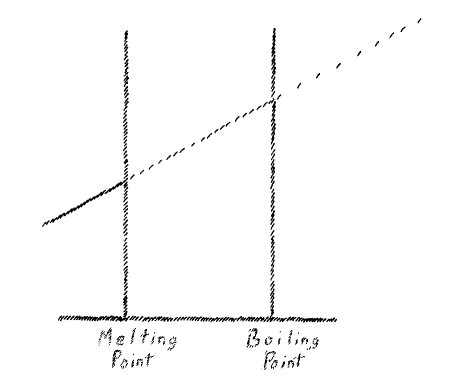
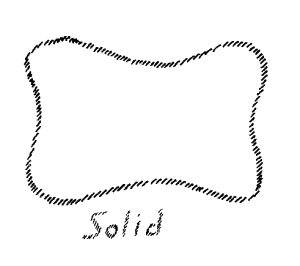
Now I will ask you to add to the fact I have brought before you, another which you will know well from ordinary experience. If you consider solids, which form our starting point, you know that they hold their shape of themselves, whatever form is given them they maintain. If I place a solid here before you it remains as it is. If you select a fluid, that is, a body that has by the application of heat been made to go through the melting point, you know that I cannot handle it piece by piece, but it is necessary to place it in a vessel, and it takes the form of the vessel, forming a horizontal upper surface. (Fig. 3) If I select a gas—a body that has been vaporized by passing through the boiling point, I cannot keep it in an open vessel such as I use for the liquid, it will be lost. Such a gas or vapor I can hold only in a vessel closed in on all sides, otherwise the gas spreads out in all directions. (Fig. 4) This holds, at least for superficial observation, and we will consider the matter first in this way. And now I would ask you to make the following consideration of these things with me. We make this consideration in order to bring facts together so that we can reach a general conception of the nature of heat. Now have we determined the rise in temperature? We have determined it by means of the expansion of quicksilver. The expansion has taken place in space. And since at our ordinary temperature quicksilver is a liquid, we must keep clear in our minds that it is confined in a vessel, and the three dimensional expansion is summed up so that we get an expansion in that direction. By reducing the expansion of quicksilver in three dimensions to a single dimension, we have made this expansion measure the temperature rise.
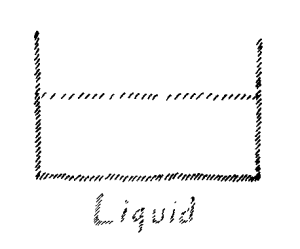
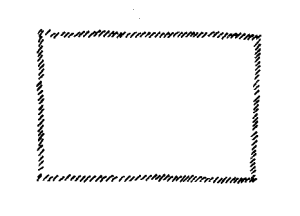
Let us proceed from this observation which we have laid out as a fundamental and consider the following: Assume a line (Fig. 5) Naturally, a line can only exist in thought. And suppose on this line there lie a number of points
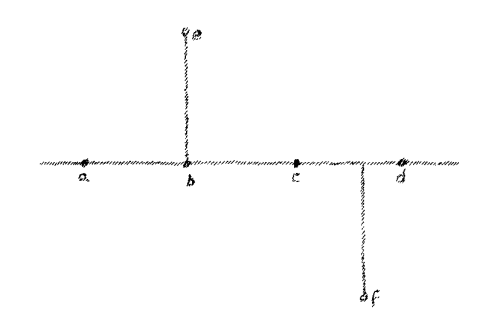
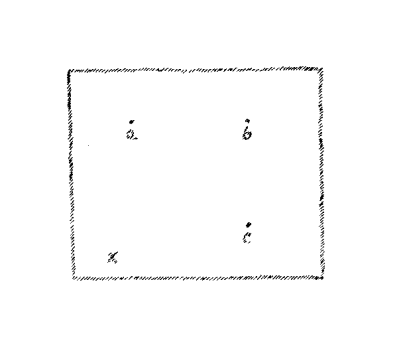
Now assume you have a surface, let us say the surface of the blackboard, and again I locate on the surface of this board a number of points;
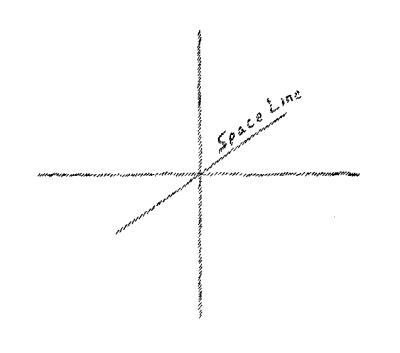
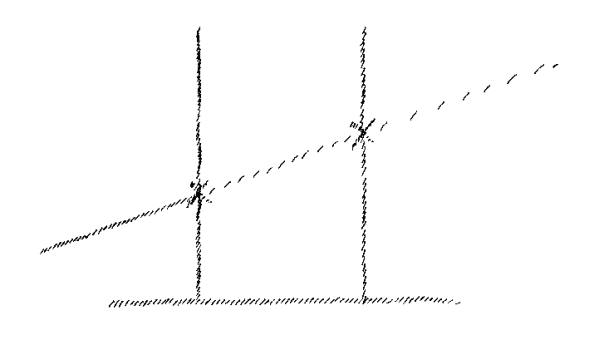
Now we have to bring another phenomenon in connection with this. Please note that in this linking together of phenomena we make progress, not in elaborating some kind of theory, but in bringing together phenomena so that they naturally illuminate each other. This is the distinction between the physics of Goethe that simply places phenomena side by side so that they throw light on each other, and modern physics which tends to go over into theories, and to add thought-out elaborations to the facts. For atoms and molecules are nothing else but fancies added to the facts.
Let us now consider another phenomenon along with this disappearance of the temperature recorded by the thermometer during the process of melting. This other phenomenon meets us when we look at yesterday's formula. This formula was written:
You remember that I said yesterday you should pay especial attention to the last two terms. It is especially important for us at this time to consider
We have, thus, a peculiar situation. When we try to grasp the heat condition, in so far as the temperature shows this condition, by means of an ordinary geometrical line, we find it cannot be done. Now this has another bearing. Imagine for a moment that I have a line. This line has a certain length:
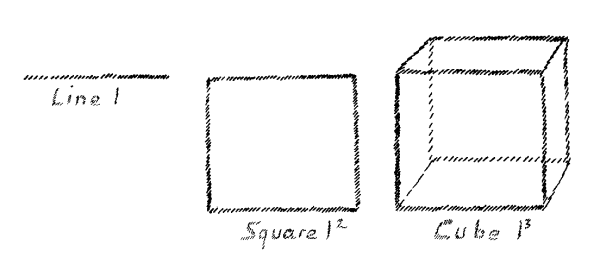
Therefore, you must realize that you have to conceive of
When you observe a triangle and determine that it has three angles, you are dealing, at the start, with a conceived triangle. Since merely thinking about it is not enough to satisfy your senses, you draw it, but the drawing adds nothing to your idea. You have given, the sum of the angles is 180, or a right-angled triangle—the square of the hypotenuse equals the sum of the squares of the other two sides. These things are handled as I now handle the power of
Let us now go back and see what we have established as fact. This is the way it is done in geometry. It is always true that when I observe an actual triangle in bridge construction or elsewhere, the abstract idea verifies itself. What I have thought of in the abstract
You see, I am showing you how we must, as it were, break a path if we wish to place together those phenomena which simply by being put side by side illustrate the being of heat and enable us to attain to an understanding similar to that reached in the preceding course of lectures on light.
The physicist Crookes approached this subject from entirely different hypotheses. It is significant that his considerations led him to a result similar to the one we have arrived at tentatively and whose validity we will establish in the next lectures. He also concluded the temperature changes had essentially to do with a kind of fourth dimension in space. It is important at this time to give attention to these things because the relativists, with Einstein at their head, feel obliged when they go outside of three-dimensional space, to consider time as the fourth dimension. Thus, in the Einstein formulae, everywhere one finds time as the fourth dimension. Crookes, on the other hand, considered the gain or loss of heat as the fourth dimension. So much for this side-light on historical development.
To these phenomena I would ask you now to add what I have formerly emphasized. I have said: An ordinary solid may be handled and it will keep its form, (Fig. 2). That is, it has a determinate boundary. A fluid must be poured into a vessel, (Fig. 3). It always forms a flat upper surface and for the rest takes the shape of the vessel. This is not so for a gas or vaporous body which extends itself in every direction. In order to hold it, I must put it into a vessel closed on all sides, (Fig. 4). This completely closed vessel gives it its form. Thus, in the case of a gas, I have a form only when I shut it in a vessel closed on all sides. The solid body possesses a form simply by virtue of the fact that it is a solid body. It has a form of itself, as it were. Considering the fluid as an intermediate condition, we will note that the solid and gaseous bodies may be described as opposites. The solid body provides for itself that which I must add to the gaseous body, namely the completely surrounding boundary.
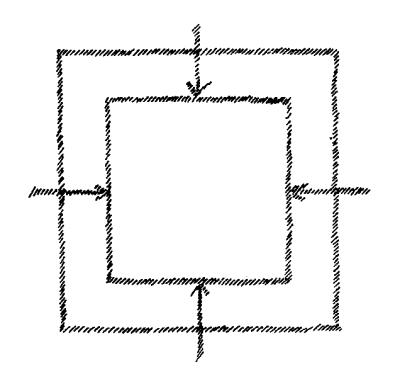
Now, however, a peculiar thing occurs in the case of a gas. When you put a gas into a smaller volume (Fig. 10), using the same amount of gas but contracting the walls all around, you must use pressure. You have to exert pressure. This means nothing else but that you have to overcome the pressure of the gas. You do it by exerting pressure on the walls which give form to the gas. We may state the matter thus: that a gas which has the tendency to spread out in all directions is held together by the resistance of the bounding walls. This resistance is there of itself in the case of the solid body. So that, without any theorizing, but simply keeping in mind the quite obvious facts, I can define a polaric contrast between a gas and a solid body in the following way: That which I must add to the gas from the outside is present of itself in the solid. But now, if you cool the gas, you can pass back again to the boiling point and get a liquid from the vapor, and if you cool further to the melting point, you can get the solid from the liquid. That is to say, you are able by processes connected with the heat state to bring about a condition such that you no longer have to build the form from the outside, but the creation of form takes place of itself from within. Since I have done nothing but bring about a change in the heat condition, it is self-evident that form is related in some way to changes in the heat state. In a solid, something is present which is not present in a gas. If we hold a wall up against a solid, the solid does not of itself exert pressure against the wall unless we ourselves bring this about. When, however, we enclose a gas in a vessel, the gas presses against the solid wall. You see, we come upon the concept of pressure and have to bring this creation of pressure into relation with the heat condition. We have to say to ourselves: it is necessary to find the exact relation between the form of solid bodies, the diffusing tendency of gases and the opposition of the boundary walls that oppose this diffusion. When we know this relation we can hope really to press forward into the relation between heat and corporeality.

